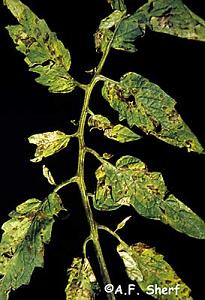Gray Leaf Spot: How to Identify and Treat It in Tomatoes
Since 2010, Tomato Dirt has garnered 4.8+ million views, making it the web’s leading online source for growing tomatoes in the home garden. Award-winning writer and Tomato Dirt owner Kathy Widenhouse has helped thousands of home gardeners grow healthier tomatoes. Be one of them when you get Tomato Dirt’s Growing Guide here.
Gray leaf spot is a disease that affects tomato leaves. It’s caused by three different fungi, Stemphylium solani, Stemphylium floridanum, and Stemphylium botryosum.
The fungus survives for a long time on plant debris, weeds, alternate hosts such as nightshade plants (peppers, eggplant, and potatoes), volunteer tomato plants, and gladiolas.
Spores are spread by wind and water. Wet weather, dew, and overhead watering help them germinate quickly.
Breeders have developed tomato varieties that are resistant to the disease. Look for disease-resistant code letters “S” or “St” (to indicate “Stemphylium”) on seed packages or plant labels.
What does gray leaf spot look like?
- Brown to black specks appear first on older leaves, then newer growth.
- Spots develop a gray center surrounded by a yellow halo. Leaves turn yellow, then brown, then drop.
- The center of the spot may fall out leaving holes.
- The entire plant may be affected.
- Fruit is not affected directly, but the disease can stunt them. When plant loses its leaves, tomatoes are susceptible to sunscald.
When and where does it affect plants?
 |
Photo: Vegetable MD Online |
- It often strikes in warm, wet weather.
- Plants with heavy amounts of tomatoes are more easily infected.
- It’s common in the southeast US.
How does it differ from Septoria leaf spot?
Symptoms between the two are similar, but there are no black spots in the center of gray leaf spot’s leaf damage.
How do you control and treat gray leaf spot?
- The best control measure for tomato blight is prevention (see below).
- Remove and destroy infected leaves (be sure to wash your hands afterwards).
- Once blight is present and progresses, it becomes more resistant to biofungicide and fungicide. Treat it as soon as possible and on a schedule.
- Organic fungicides. Treat organically with copper spray, which you can purchase online, at the hardware store, or home improvement center. Follow label directions. You can apply until the leaves are dripping, once a week and after each rain. Or you can treat it organically with a biofungicide like Serenade. Follow label instructions.
- Chemical fungicides. Some gardeners prefer chemical fungicides, the best of which for tomatoes is chlorothalonil (sold as Fungonil, Daconil, or under other brand names. Check labels. You may also choose Mancozeb or Maneb, although these have longer wait times before you can harvest tomatoes safely than does chlorothalonil.
Other diseases (such as early blight, late blight, and gray leaf spot) can also be controlled by these biofungicides and fungicides, so application is multi-purpose.
How do you prevent gray leaf spot?
- Plant disease-resistant hybrids to strengthen your plant’s chances of being disease-free.
- Rotate crops. Fungus spores can remain in the soil and plant debris for several years.
- Avoid planting tomatoes in the shade.
- Avoid planting tomatoes where peppers, eggplants, or potatoes were grown the year before.
- Plant tomatoes in a raised bed to improve drainage and prevent diseases from spreading.
- Give tomato plants extra space (more than 24 inches) to let air to move among leaves.
- Keep leaves as dry as possible. Water the soil – not the plants – to prevent splashing. Avoid overhead watering.
- Stake tomato plants for better circulation.
- Remove and destroy volunteer plants.
- Remove and destroy affected plants or deep plow tomato plants into the ground at the end of the season.
More on tomato diseases and tomato blight
How to identify and treat late blight ...
How to identify and treat early blight ...
How identify and treat Septoria leaf spot ...
How to choose and apply fungicide to tomato plants ...
How to identify and treat fusarium wilt ...
How to identify and treat verticillium wilt ...
How to identify and treat walnut wilt ...
How to Identify and Treat Tomato Spotted Wilt Virus...
Why Do Tomato Leaves Curl – and What To Do About It ...
How to identify and treat phosphorus deficiency in tomatoes ...
How to identify tomato problems and prevent them ...
Get more info on our Tomato Diseases Pinterest board...
Return from Gray Leaf Spot to Tomato Dirt home
As an Amazon Associate and Rakuten Advertising affiliate I earn from qualifying purchases.
SHARE THIS PAGE:
FREE! 10 Must-Know Tomato Growing Tips: 20-page guide
Get yours here:




New! Comments
Have your say about what you just read! Leave a comment in the box below.